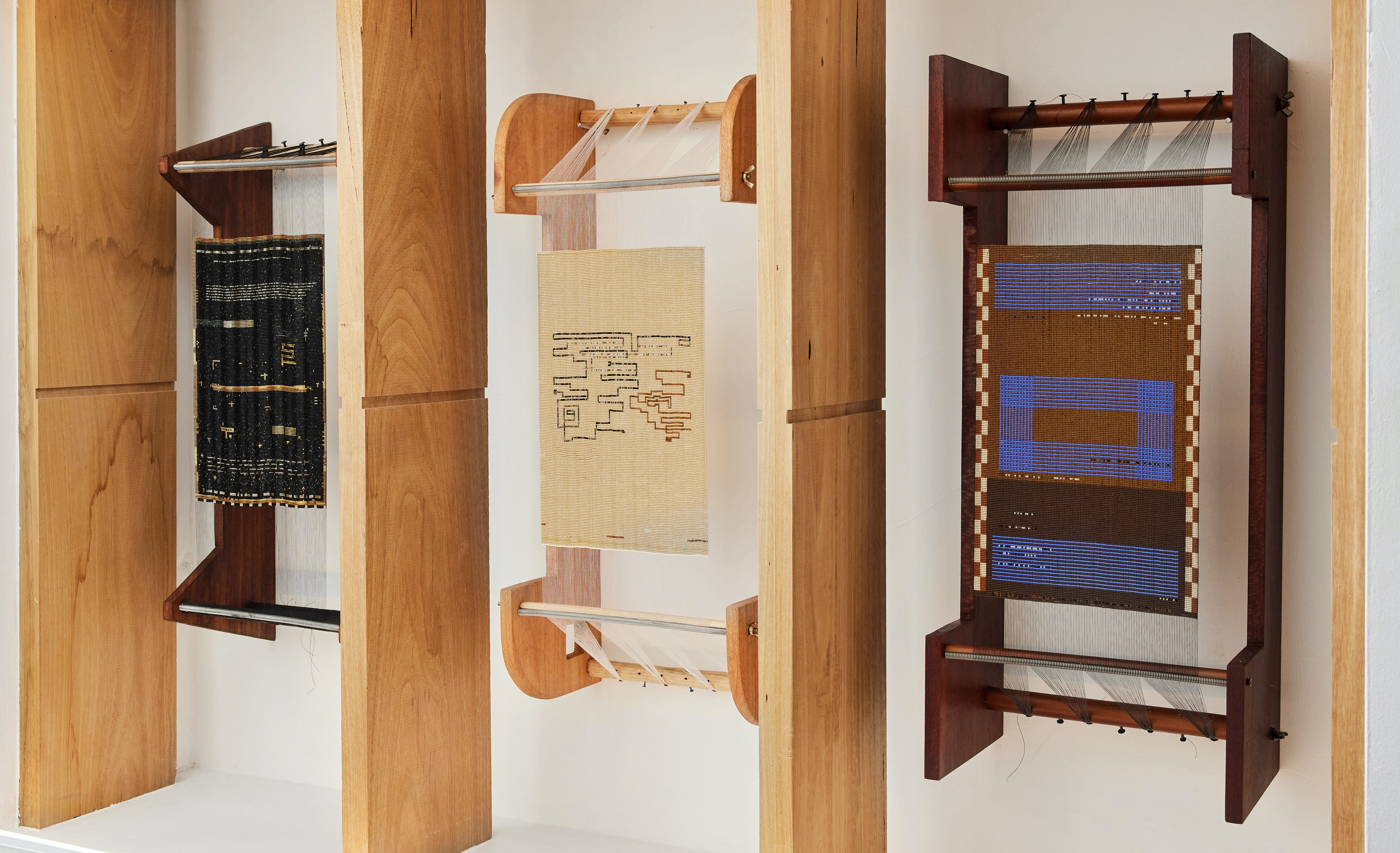
Beading artist Camille Laddawan creates delicate works inscribed with fragments of text. To create her compositions, she translates chosen words and phrases into a visual code that allows her to embed ideas within her beading work. Camille draws on methods of institutional analysis to explore socio-political concerns that intersect with personal and familial experiences.
In her Vitrine Gallery exhibition Infinite Refgress, Camille presents a series of three beaded artworks on hand-made wooden looms, with coded messages woven into the works. We chatted to Camille about her practice and motivations behind the exhibition.
Tell us about how you came to work with beading?
One of my jobs prior to the pandemic was working as a weaver. Working with the tension, repetition and sustained labour of weaving felt innate, but I didn’t relate to the lightness or continuousness of yarn. When all my work was put on hold, I bought a small beading loom. I found it simpler yet fiddlier and the beads were heavier and smoother than yarn. The beads are under 2mm in size and I like how each individual bead comes together to make a fabric of glass. The mathematical element of counting and measuring feels grounding, and I like working within the parameters of the grid. Unlike weaving, which has been industrialised, loom beading is still a practice produced by hand. I feel like I have always been a beader, it just happened to come to the surface after all these years.


We would love to know more about your Tone Code - what inspired this method and how does it work in practice?
Tone Code is a visual alphabet I have adapted from Morse Code. Each letter of the English language, and punctuation, is represented by a unique combination of light and dark tones. Tone Code has a dual function. Firstly, it allows me to embed writing within my work (literal meaning). Secondly, it gives my work symbolic meaning. The fact that the writing is illegible unless decoded by the reader references ongoing themes in my work, of communication/miscommunication between the individual and the institution.
Can you talk to the theme of your exhibition Infinite Regress?
Infinite Regress examines cultural relationships with death and the body. For this exhibition, with the help of Dying With Dignity Victoria, I placed a public call-out for responses to the question: 'What would you do with your body after death, if there were no laws or restrictions, a limitless budget and no environmental or socio-political concerns?'
Five answers were chosen for inclusion in three beaded artworks, woven on hand-made wooden looms. From over a hundred responses, the majority of answers included or referred to practices of burial and cremation, the choices we are often presented with through the legal course of death. The aim of this exhibition is to generate thought and conversation beyond burial and cremation: to consider how Australian laws affect our capacity to imagine possibilities for our bodies after death; and how what we desire and imagine also shapes the formation of the law.
You have a background in art therapy, how does this inform your practice?
When I was studying at La Trobe University, my main area of research was on the neurological effects of art materials, and how they influence emotional regulation. More recently, I have become curious about the function of repetition in relation to bead work. Weaving, printmaking and mark-making practices such as Cy Twombly’s asemic writing works, or the grids in Agnes Martin’s works, also engage repetition. The literature regarding repetition in art psychotherapy is conflicting: many heavily link it to a symptom of disorder and trauma; some to cultural tradition; and others to generative processes. Art therapy has encouraged me to enquire more about the material affects of my own artistic processes, and to write companion pieces to my artworks (I haven’t published any just yet).
What’s next for you? Any exciting projects in the works?
I am developing a music code, and will be translating ‘Opus No. 1’ by Tim Carleton into a beading. This song is one of the most popular pieces of hold music, and is used by the Australian Government’s Centrelink call centre (some of you may have heard it). The work is part of an ongoing series called ‘Ref.’ that explores the ways in which institutions use language and codified systems of communication (including music) to create experiences of delay, deferral and time-warp. This work will link beading as a durational, embodied process, with Bergson’s definition of ‘lived time’: the way our inner subjective experiences are felt, lived and acted against ‘objective’ or institutional time. The work will be presented in the West Space window in February 2023.
Infinite Regress is on show in the Vitrine Gallery from October 4, 2022, 10:00 AM — November 5, 2022, 4:00 PM
Interview by Anni Hagberg.
Header image photographed by Henry Trumble. All other images courtesy the artist.